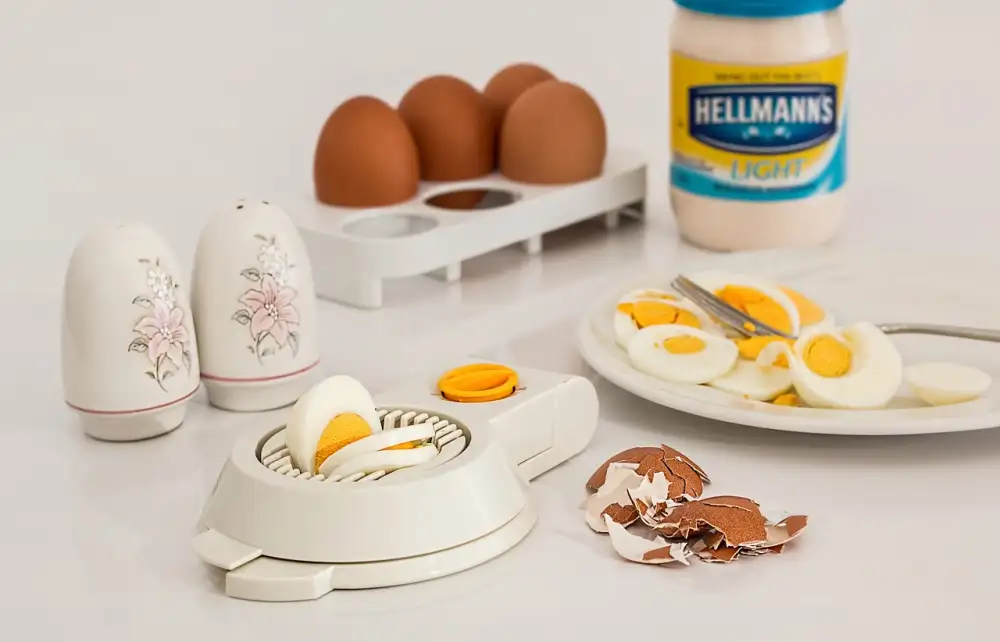Perfectly Hard-Boiled Eggs: A Foolproof Guide to Cooking and Enjoying this Classic Delight

- Step-by-step guide for making hard-boiled eggs
- Place eggs in a saucepan
- Add enough water to cover the eggs
- Bring the water to a boil
- Reduce heat and let eggs simmer for a specific time
- Prepare an ice bath
- Transfer eggs to the ice bath
- Tips for perfectly cooked hard-boiled eggs
- Adjust cooking time based on desired yolk consistency
- Use older eggs for easier peeling
- Gently tap eggs on a hard surface to crack the shell
- Serving suggestions and creative uses for hard-boiled eggs
- Enjoy as a standalone snack
- Use in salads, sandwiches, or wraps
- Make deviled eggs or egg salad
- Incorporate into breakfast or brunch dishes
Hard-boiled eggs are a versatile and nutritious food that can be enjoyed in various ways. Whether you prefer them as a quick snack, a salad topping, or in your favorite recipes, mastering the art of cooking the perfect hard-boiled egg is essential. With their firm whites and creamy yolks, hard-boiled eggs are not only delicious but also packed with protein and essential nutrients. In this foolproof guide, we will take you through the steps to achieve perfectly cooked hard-boiled eggs every time. So grab your saucepan and let's get started on this culinary adventure!
Step-by-step guide for making hard-boiled eggs
a. Place eggs in a saucepan.
b. Add enough water to cover the eggs.
c. Bring the water to a boil.
d. Reduce heat and let eggs simmer for a specific time.
e. Prepare an ice bath.
f. Transfer eggs to the ice bath.
Follow these simple steps for perfectly cooked hard-boiled eggs every time!
Place eggs in a saucepan
To begin the process of making perfectly hard-boiled eggs, start by placing the desired number of eggs in a saucepan. Make sure to use a pan that is large enough to comfortably fit all the eggs in a single layer. This will help ensure even cooking and prevent overcrowding.
Add enough water to cover the eggs
Once the eggs are in the saucepan, it's time to add enough water to cover them completely. The water level should be about 1 inch above the eggs. This ensures that the eggs cook evenly and prevents them from cracking during the boiling process. Adding too little water may result in uneven cooking, while adding too much water can cause the eggs to bounce around and potentially crack. So, make sure to measure carefully and add just enough water to cover the eggs.
Bring the water to a boil
Once the eggs are in the saucepan and covered with water, it's time to bring the water to a boil. Place the saucepan on the stove over medium-high heat and allow the water to come to a rolling boil. This typically takes about 8-10 minutes. Keep an eye on the pot as it heats up, but avoid stirring the eggs too much during this process. Once the water is boiling, you can move on to the next step in achieving perfectly hard-boiled eggs.
Reduce heat and let eggs simmer for a specific time
Once the water has come to a boil, reduce the heat to low and let the eggs simmer for a specific time. The cooking time will depend on how well-done you prefer your yolks. For a soft-boiled egg with a runny yolk, simmer for about 4-6 minutes. For a medium-boiled egg with a slightly creamy yolk, simmer for 8-10 minutes. And for a fully hard-boiled egg with a firm yolk, simmer for 12-14 minutes. Adjust the cooking time accordingly to achieve your desired consistency.
Prepare an ice bath
To prepare an ice bath for your hard-boiled eggs, fill a large bowl with cold water and add plenty of ice cubes. The ice bath serves to rapidly cool down the eggs and stop the cooking process. This step is crucial in ensuring that your eggs are perfectly cooked and easy to peel. Once the eggs have finished simmering, carefully transfer them to the ice bath using a slotted spoon or tongs. Let them sit in the ice bath for at least 5 minutes before peeling. The cold water will help shrink the egg whites away from the shell, making it easier to remove later on.
Transfer eggs to the ice bath
e. Prepare an ice bath: Once the eggs have finished simmering, carefully transfer them to a bowl filled with ice water using a slotted spoon. The ice bath will rapidly cool down the eggs and stop the cooking process. Let the eggs sit in the ice bath for at least 5 minutes to ensure they are fully cooled. This step is crucial as it helps prevent the formation of a greenish-gray ring around the yolk and ensures easy peeling later on. The cold water also helps separate the egg white from the shell, making it easier to remove. Once cooled, gently tap each egg on a hard surface to crack the shell before peeling.
Tips for perfectly cooked hard-boiled eggs
a. Adjust cooking time based on desired yolk consistency. For a soft, runny yolk, simmer the eggs for about 5-6 minutes. For a slightly firmer yolk, cook for 8-10 minutes. And for a fully set yolk, boil for 12-14 minutes.
b. Use older eggs for easier peeling. As eggs age, the air pocket inside expands, making them easier to peel after cooking.
c. Gently tap eggs on a hard surface to crack the shell before peeling. This will help loosen the shell and make it easier to remove without damaging the egg.
Remember these tips to ensure your hard-boiled eggs turn out perfectly every time!
Adjust cooking time based on desired yolk consistency
When it comes to cooking hard-boiled eggs, the cooking time plays a crucial role in achieving the desired yolk consistency. If you prefer a soft and slightly runny yolk, cook the eggs for around 6-7 minutes. For a fully set but still creamy yolk, aim for 9-10 minutes of cooking time. And if you prefer a completely firm and solid yolk, cook the eggs for about 12-13 minutes. Remember to adjust the cooking time accordingly to achieve your perfect hard-boiled egg with the ideal yolk consistency.
Use older eggs for easier peeling
Tips for perfectly cooked hard-boiled eggs:
b. Use older eggs for easier peeling
Using older eggs, which are typically around one week old, can make the peeling process much easier. As eggs age, the air pocket inside expands, creating a small gap between the shell and the egg white. This makes it simpler to remove the shell without damaging the egg itself. So, if you have some eggs sitting in your fridge for a while, they would be perfect for making hard-boiled eggs with smooth and effortless peeling.
Gently tap eggs on a hard surface to crack the shell
To make peeling easier, gently tap the hard-boiled eggs on a hard surface to crack the shell. Be careful not to hit too hard and break the egg. This will create small cracks in the shell, allowing for easier removal later on. Once cracked, start peeling from the wider end of the egg where there is usually an air pocket. The shell should come off more easily, leaving you with perfectly peeled hard-boiled eggs ready to be enjoyed or used in your favorite recipes.
Serving suggestions and creative uses for hard-boiled eggs
Serving suggestions and creative uses for hard-boiled eggs are endless. They can be enjoyed as a standalone snack, sprinkled with salt and pepper. Hard-boiled eggs are also perfect for salads, sandwiches, or wraps, adding a protein boost to your meal. Get creative by making deviled eggs or egg salad with various flavor combinations. Incorporate hard-boiled eggs into breakfast or brunch dishes like avocado toast or breakfast burritos. The versatility of hard-boiled eggs makes them a must-have ingredient in any kitchen.
Enjoy as a standalone snack
Hard-boiled eggs can be enjoyed as a standalone snack, providing a quick and nutritious option for those on the go. Simply peel the egg and enjoy its firm yet creamy texture. Sprinkle with a pinch of salt and pepper for added flavor, or try dipping it in your favorite sauce or condiment. This versatile snack is not only satisfying but also packed with protein, making it an excellent choice for a midday pick-me-up or post-workout fuel.
Use in salads, sandwiches, or wraps
Hard-boiled eggs are a versatile ingredient that can elevate the taste and texture of salads, sandwiches, or wraps. Their creamy and slightly firm texture adds a delightful contrast to crisp greens or bread. Slice them and toss them into a refreshing salad for added protein and richness. Layer them in a sandwich with fresh vegetables and condiments for a satisfying lunch option. Roll them up in a wrap with your favorite fillings for a portable and nutritious meal on the go. The possibilities are endless when it comes to incorporating hard-boiled eggs into these dishes, making them even more delicious and satisfying.
Make deviled eggs or egg salad
Deviled eggs and egg salad are two classic dishes that showcase the versatility of hard-boiled eggs. To make deviled eggs, simply slice the hard-boiled eggs in half lengthwise and remove the yolks. Mash the yolks with mayonnaise, mustard, salt, and pepper until smooth. Spoon or pipe this mixture back into the egg whites and garnish with paprika or fresh herbs. The result is a creamy and flavorful appetizer that is perfect for parties or gatherings.
Egg salad is another delicious option that can be enjoyed as a sandwich filling or served on a bed of greens. Chop the hard-boiled eggs into small pieces and combine them with mayonnaise, diced celery, chopped green onions, mustard, salt, and pepper. Mix well and adjust seasonings to taste. Spread this mixture onto bread slices or serve it over lettuce leaves for a refreshing and satisfying meal.
Both deviled eggs and egg salad can be customized with additional ingredients such as diced pickles, bacon bits, or fresh herbs to add extra flavor and texture. These dishes are not only easy to prepare but also great ways to use up leftover hard-boiled eggs. So next time you have some hard-boiled eggs on hand, consider making deviled eggs or egg salad for a tasty treat!
Incorporate into breakfast or brunch dishes
Incorporate into breakfast or brunch dishes: Hard-boiled eggs are a versatile ingredient that can elevate your breakfast or brunch dishes. Slice them and serve on toast with avocado for a nutritious and filling meal. Crumble them over a bowl of creamy oatmeal for added protein and texture. Or, chop them up and mix with diced vegetables for a hearty breakfast hash. The possibilities are endless when it comes to incorporating hard-boiled eggs into your morning meals!
In conclusion, hard-boiled eggs are a versatile and nutritious addition to any meal. With this foolproof guide, you can easily achieve perfectly cooked eggs every time. Whether you enjoy them as a snack, in salads or sandwiches, or get creative with deviled eggs and egg salad, the possibilities are endless. Remember to adjust cooking time for your desired yolk consistency and use older eggs for easier peeling. So go ahead and explore the culinary delights of hard-boiled eggs – they are sure to satisfy your taste buds!
Published: 24. 11. 2023
Category: Food



